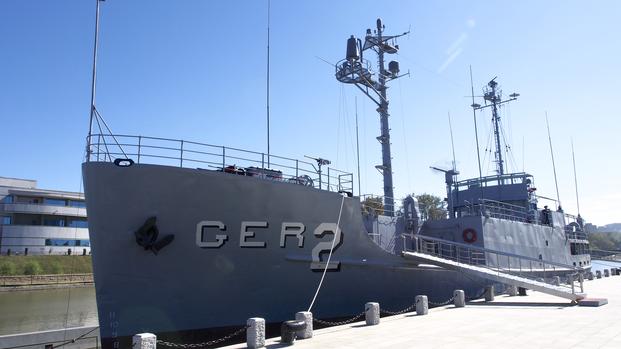Fire-and-brimstone tensions with North Korea keeping you awake at night? Things aren't that bad. There are at least two previous (acknowledged) incidents where we've actually come close to obliterating the leadership of North Korea.
1. The USS Pueblo and Operation Freedom Drop

USS Pueblo
Rewind back to 1968. The USS Pueblo, disguised as a research vessel, was captured as it spied on North Korea.
According to crew reports and Navy officials, the USS Pueblo was in international waters off the Korean shore on January 23, 1968, when a North Korean submarine chaser challenged its nationality. When the vessel raised the U.S. flag, it was given a choice: stand down and prepare to be boarded or be fired upon.
Related:
Lawmakers Unite in Return of USS Pueblo
Oakland Author Tells Story of USS Pueblo
Skip Schumacher, Operations Officer of the Pueblo, later said in a BBC interview: "The Pueblo had no armor protection whatsoever; we were no match for 4 torpedo boats, 2 submarine chasers and MiG jet aircraft. Not very good odds."

As the Pueblo tried to flee, she was fired upon without so much as a warning shot. One crewman was killed and 18 injured in the attack. Commander Bucher broke off the run and surrendered to save the rest of his crew.

FILE - In this photo released by the U.S. Navy, crew members of the USS Pueblo hold up their hands while in captivity in North Korea in 1968. Many of the crew who served on the vessel, then spent 11 months in captivity in North Korea, want to bring the Pueblo home. Throughout its history, they argue, the NavyÂs motto has been ÂdonÂt give up the ship. The Pueblo, in fact, is still listed as a commissioned U.S. Navy vessel, the only one being held by a foreign nation. (AP Photo/US Navy)
The commander and crew were brutally tortured over the next year.
Finally, when the interrogators threatened to shoot his crew one by one, starting with the youngest, Commander Bucher gave in and signed a confession. The U.S. was able to secure the release of the commander and crew with a series of apologies and confessions, most notably by U.S. Army Major General Gilbert H. Woodward.

Repatriation of USS Pueblo crew
President Lyndon Johnson was advised to call the capture of the Pueblo an act of war and to launch a nuclear attack. Although Johnson ultimately opted for a diplomatic approach, declassified documents reveal that using nuclear weapons was a real Plan B. Codenamed 'Freedom Drop,' the plan envisioned using nukes to attack North Korea's leadership and military forces.

USS Pueblo at the Fatherland War of Liberation Museum in North Korea
In the following years, the commander and crew of the Pueblo were spared a court-martial, with Secretary of the Navy John Chafee stating that the crew had been through enough. The North Koreans and Soviets were able to reverse-engineer the Pueblo's communication devices, which gave them great insight into the U.S. Navy's communication capabilities until the late 1980s.
The crew also had to wait until 1990 before their almost year-long ordeal was officially recognized by the U.S. government. Awards were given to members of the crew, including two silver stars and a Navy Cross. The acclaim was not universal; there are still some within the Navy who say the commander and crew should have fought to the death and not allowed themselves to be captured.
To this day, it is the only U.S. Navy vessel held by a foreign government.
2. Now Kim Jong-Un is in the crosshairs

Fast forward to this year, specifically July 4. North Korea launched its first intercontinental ballistic missile, giving the U.S. another great excuse to annihilate North Korea's leadership. Let freedom ring?
(It is important to note that North Korea claims that in early 2017 the CIA made a failed assassination attempt against Kim Jong-un with a biological weapon. The U.S. has not responded to the allegation.)
On the day of North Korea’s intercontinental ballistic launch, U.S. military and intelligence personnel had Kim Jong-un in their "crosshairs, as he smoked cigarettes and strolled around the launchpad," according to The Diplomat's confidential sources.
It's no secret that the U.S. makes a great effort to closely monitor all military movement in North Korea. Military officials watched Kim Jung-un for more than an hour and did nothing, the sources said.

North Korea Nuclear Missile Launch
President Donald Trump's rhetoric echoes the sentiments of Johnson's advisors back in 1968. Some observers believe we are now as close to using nuclear weapons against a foreign power as we were back in the late 1960s.
Experts at several political think tanks, including Asia Pacific and South Asia at Stratfor, say that the U.S. is sending a clear message to North Korea: We're watching you and can take you out at any moment.
-- Sean Mclain Brown can be reached at sean.brown@military.com. Follow him on Twitter at @seanmclainbrown.





